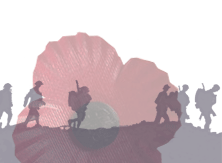The Anderson Brothers

Their names will be remembered for evermore
The story of four brothers whose deaths spanned the length of the war reveals how hard losses hit one family. Two died early on, and two in the spring before the Armistice, in 1918.
Bertie, Ronnie, Charlie and Teddie were the children of accountant William Anderson and his wife Eleanora. The couple had lost their third son, Harry, a week after he was born, in 1887. The family lived in the West End of Glasgow, settling in Woodside Terrace in 1900. The boys attended Fettes College in Edinburgh.
Charlie was born in 1888. He was the fourth son and a career soldier, joining the 1st Battalion, The Highland Light Infantry, in Lucknow, India, in 1908. Admiring him as a keen sportsman and 'debonair young soldier', colleagues nicknamed him 'The Babe', reported The Highland Light Infantry Chronicle. He arrived in the trenches near Givenchy on 12 December, 1914 but, a week later, was presumed dead after German bombers blew through the front trench. He is the only brother to have no grave, and his name is listed at Le Touret Military Cemetery in Pas-de-Calais in France.
Taking his Brother's Place
Alexander Ronald - Ronnie - was the second Anderson son. He was farming in Rhodesia when war broke out, but enlisted, joining Lovat's Scouts. He was commissioned into The Highland Light Infantry, reaching France in May 1915. Charlie's death had only been announced the previous month, and when Ronnie heard the news he was determined to 'fill his place, only to meet a similar fate', reported The Highland Light Infantry Chronicle. He was shot in the trenches on 8 October, 1915 at Vieille Chapelle. He is buried at Cabaret-Rouge British Cemetery at Souchez, France.
A Talented Pilot
Edward - Teddie - was the youngest. He, too, had joined The Highland Light Infantry in 1914, but transferred to The Royal Flying Corps, which was in its infancy. He saw action at the Somme, but his talent as a pilot saw him promoted to instructor in Winchester, in the south of England. He too gave his life to the war, in a plane over Winchester on 16 March, 1918. Teddie was the only one of the four soldier sons to 'come home' - he was buried in Bearsden, his father's childhood home.
Counter-attack
Only eight months before the war ended, and just a week after Teddie's death, the eldest of the Anderson boys fell. Lt Col William Herbert Anderson - Bertie - was an army reservist who had followed his father into accountancy, commuting to the family firm in Glasgow from Cardross, where he lived with his wife Gertrude and sons. Bertie was Commanding Officer of the 12th Battalion, The Highland Light Infantry. Records describe him as a 'genial and cultured gentleman' who died 'fighting within the enemy's lines'. He died on 25 March, 1918, at Maricourt, France, in the second of two counter-attacks he had led that day. He was awarded the Victoria Cross.
Even before they lost any of their sons, Eleanora and William Anderson were heavily involved in supporting regimental charities. Eleanora co-ran a depot collecting extra medical supplies to be sent to the front, while William was awarded the CBE for fundraising for the Red Cross Scottish branch. After the war, he applied for all his sons' medals. Their story was the basis of the novel The Way Home, by Robin Scott-Elliot, a descendant.
The Andersons retired to Largo in Fife. Their sons' sacrifice was marked with a plaque at Glasgow Cathedral in 1920. They are also named on many other memorials, including those at Fettes College, Glasgow Academy War Memorial, the Royal Military Academy at Sandhurst, where Charlie trained, and Cardross War Memorial.
View original referenced text here: Anderson Brothers (PDF, 100 KB)
Images:
- Charles Hamilton Anderson, from the Highland Light Infantry Chronicle, 1915. Credit: The Royal Highland Fusiliers Museum, Glasgow.
![Anderson1]()
- Edward (Teddie) Anderson, Royal Aero Club book. Credit: Courtesy of The Royal Aero Club Trust.
![Anderson2]()
- Lt Col William H (Bertie) Anderson VC, from The Outpost, 1918. Credit: Courtesy of The Royal Highland Fusiliers Museum, Glasgow
![Anderson3]()







